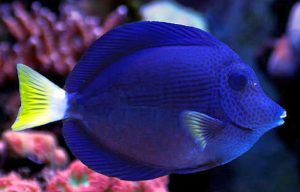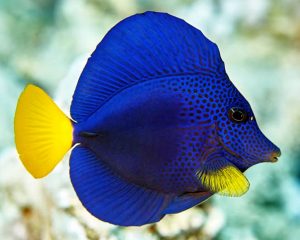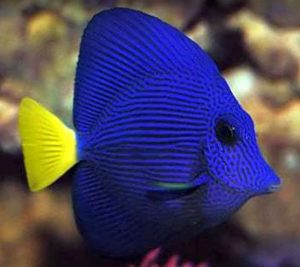The Purple Tang (Zebrasoma xanthurum) known to tropical fish keeping enthusiasts as the Yellowtail Tang, Yellowtail Surgeonfish, or Blue Surgeonfish is native to the Red Sea however, they have also been encountered in the Gulf of Aden, the Persian Gulf, the Arabian Sea, and recently in the Mediterranean Sea near Sardinia. They have been recorded from Maldives.
Although the Purple Tang is most abundant in the coral reefs of the Red Sea, smaller numbers are found in the Arabian Sea, the western Indian Ocean, the Gulf of Aden, and the Persian Gulf.
Adult Purple Tangs are usually encountered swimming in large groups over rocky bottoms and the coral rich reefs of their range where they spend the majority of their time grazing voraciously on filamentous algae at depths from 6 to well over 65 feet. Juvenile Purple Tangs are more solitary and prefer the shallower waters over coral rich reefs. As they mature they form schools and become more easy going.
During daylight hours, Purple Tangs are extremely active as they forage on algae among the substrate. At night they shelter between the rocks to protect themselves from larger predatory reef species.
Purple Tangs have numerous small pharyngeal teeth that are used to scrape filamentous algae from the rocks and substrate. It is an excellent rock cleaner and will quickly eliminate any nuisance algae found in your aquarium.
Zebrasoma xanthurum have moderately elevated dorsal and anal fins , a deep body, and a protruding snout mottled with dark spots that continue to the abdomen, anterior body, and forehead. Although some Purple Tangs have a deep rich blue or indigo shaded body color, most are colored a vivid purple with a bright yellow, slightly rounded tail, and yellow tipped pectoral fins.
Tiny black dots, which in most cases are barely perceptible through the deep purple body color, form somewhat scribbly thin horizontal bands towards the posterior of the body.
Juveniles have a dark blue body color with grey striping and a yellow caudal fin. The blue color darkens into a deep purple or less frequently into a deep dark blue as they mature. Males are slightly larger than females.
The Purple Tang is best housed in a mature FOWLR or reef tank of at least 125 gallon capacity with a fine crushed coral or sandy substrate, substantial quantities of mature algae encrusted live rock arranged into crevices, caves, and overhangs for them to graze and hide among, plenty of free swimming space, and a good amount of water movement. They are completely reef safe and will not harm corals, decorative clams, or sessile invertebrates.
Purple Tangs can be very aggressive and do not do well with tank mates of similar body shape; especially other Tangs of the genus Zebrasoma. Although their hyperactive swimming nature can intimidate most shy, docile, and passive species; they can be kept with many reef species. Some good tankmates include Blood Red Fire Shrimp, Skunk Cleaner Shrimp, Blue-Green Chromis, Lyretail Anthias, Majestic Angelfish, Coral Beauty Angelfish, Foxface Rabbitfish, Tomato Clownfish, Wrasses, and Neon Gobies.
Zebrasoma xanthurum are virtually impossible to breed in an aquarium environment. They are difficult to sex and the cost of establishing a breeding pair would be prohibitive. They are broadcast spawners that would require a huge commercial tank for them to mate and produce offspring. In the Red Sea mainly during the late winter to early spring, males and females swim up into the water column to the surface where the females releases their eggs and the males immediately fertilizes them. The planktonic eggs drift with the current along the surface until they hatch. The finless fry live off the yolk sack until it is completely absorbed, at which point the fry drift to the bottom of the reef feeding on microalgae until they grow into juveniles
The Purple Tang is an omnivore that in the wild grazes heavily on plant based foods, primarily filamentous algae which they are constantly devouring. In an mature aquarium environment with plenty of algae encrusted live rock, they need a constant supply of marine based algae and seaweed in their diet to strengthen their immune system, reduce aggression, and remain healthy. Dried seaweed (Nori) tied to a rock or in a veggie clip should be offered 3 or more times per week. Sea Veggies,
Seaweed Salad and Ocean Nutrition are also easy to use seaweed supplements.
The Purple Tang (Zebrasoma xanthurum) is commonly available to tropical fish keeping enthusiasts from specialty fish shops, online wholesalers, retailers, and trans shippers at the following approximate purchase sizes: Small: 1-1/2″ to 2″; Small/Medium: 2″ to 2-3/4″; Medium: 2-3/4″ to 3-1/2″; Medium/Large: 3-1/2″ – 4″ Large: 4″ to 5″. Prices vary depending on size but start around $219.99 for small specimens to over $499.00.
Minimum Tank Size: 125 gallons
Aquarium Type: Reef or FOLR
Care Level: Moderate
Temperament: Semi Aggressive
Aquarium Hardiness: Hardy
Water Conditions: 74-82° F, dKH 8-12, pH 8.1-8.4, sg 1.020-1.025
Max. Size: 10″
Color Form: Purple, Blue, Yellow
Diet: Herbivore
Compatibility: Reef
Origin: Red Sea
Family: Acanthuridae
Lifespan: 10+ years, 30 – 45 years in the wild
Aquarist Experience Level: Intermediate





One Response to “Purple Tang (Zebrasoma xanthurum)”
Trackbacks/Pingbacks
[…] Dottybacks, Dartfish, Gobies, Blennies, Damselfish, and Anthias. They will also get along with Purple Tangs (Zebrasoma xanthurum), Powder Blue Tangs (Acanthurus leucosternon), and dwarf angelfish like the Flame Angelfish […]